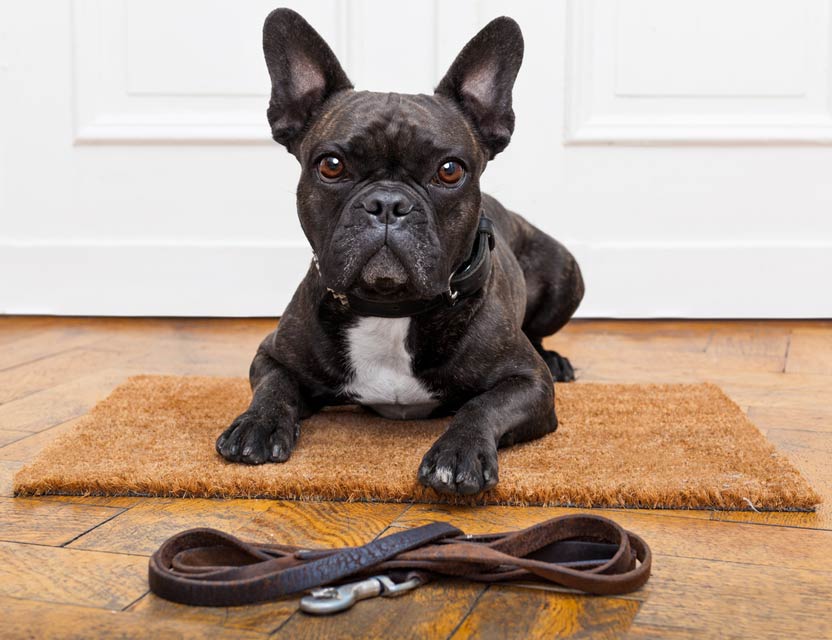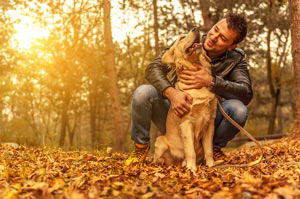The Benefits of Walking Your Dog

Having a dog in the family brings many joys, lots of fun, and some work. Luckily, much of the time, the fun parts and the work parts overlap. This is the case when it comes to walking your dog. However, it's easy to get into a rut and start feeling like the daily dog walk is more chore than cheer. These are the times when it's good to remember all the many benefits of walking your dog.
Weight Control for Your Dog
Obesity is becoming an epidemic among dogs in the United States. As their role has turned more toward household companion and less toward working partner, our canine friends have been developing more weight issues. A dog that is overweight is more prone to a plethora of health problems including diabetes, joint degeneration, heart conditions, and even cancer. Daily walking can help you control your dog's weight. Check with your veterinarian before you begin a new walking routine. You can learn more in this article: "Walking Your Dog to Help with Weight Loss."
Weight Control for You
Obesity is as much of an epidemic in humans in the United States as it is in dogs. Walking your dog daily will give you extra exercise tailored right into your day. When you walk your dog first thing in the morning, you can get your metabolism going early, setting you up for more calorie-burning all day long. Forgoing some evening television time for another walk will help you burn even more calories. Check with your doctor and your dog's veterinarian before embarking on a new walking regimen to determine how far you should go. Then consider a wearable monitor such as a Fitbit to help you keep track.
Improvement for Your Dog's Digestive and Joint Health
Walking can keep your dog's digestive tract moving and help relieve constipation. Routine movement can also keep your dog's joints lubricated and healthy. Most of the time, even dogs with arthritis can go for short walks and doing so can help slow down the degenerative process. Be sure to check with your veterinarian first to ensure that it is safe for your individual dog to walk routinely. Incidentally, walking can help you with your digestive and joint health, too.
Socialization for Your Dog
Getting your dog out and about so he can get used to being around other dogs, people, squirrels, birds, and everything else that goes on out there can help him be a better-rounded canine citizen. The sights, sounds, and smells that are found outside are all invaluable stimuli to which it's good to condition your dog. This is especially important for puppies because it helps them learn to be relaxed and confident in a variety of situations. Be sure to check with your veterinarian to find out if your puppy is ready to be taken out and about.
Socialization for You
It can be easy to get into your routine and miss opportunities to interact with people other than those you see every day at home and work. Taking your dog for a walk gives you a chance to meet and greet your neighbors and experience that important aspect of the community. In fact, walking with your dog can even help you make friends. You can read "Dogs Make the Best Matchmakers" for more information.
It's Important for Your Dog's Mental Health
Dogs evolved as herders, hunters, and protectors, not couch potatoes. They love to sniff, move around, and explore. Dogs that don't get enough mental and physical stimulation may develop unwanted behaviors such as chewing on household belongings, licking incessantly at themselves, urinating or defecating in the house, or eating non-food items. Conditions such as separation anxiety can be worsened by lack of exercise and stimulation, too. Walking routinely can help avoid or decrease many of these canine problems.
Final Words
When walking your dog begins to feel like a chore, remember all of the benefits that it affords to you and him. You can also try some of the following tips to beat your dog-walking doldrums:

- Try hiking on a nearby trail instead of walking around the neighborhood.
- Walk to a canine-fun destination such as a dog park, pet store, or pet friendly restaurant patio.
- Ask a friend with a dog to walk with you.
- Vary your route, even if it's just a little, each day to fight boredom.
And, if all of that still leaves you hesitating to clip the leash onto your dog's collar, consider one of the biggest benefits to daily dog walking of all: the resultant bonding between you and your dog.
You May Also Like These Articles:
Retractable Dog Leashes: Know the Risks
The Yellow Dog Project: What Does the Yellow Ribbon Mean?
Disclaimer: This website is not intended to replace professional consultation, diagnosis, or treatment by a licensed veterinarian. If you require any veterinary related advice, contact your veterinarian promptly. Information at DogHealth.com is exclusively of a general reference nature. Do not disregard veterinary advice or delay treatment as a result of accessing information at this site. Just Answer is an external service not affiliated with DogHealth.com.
Notice: Ask-a-Vet is an affiliated service for those who wish to speak with a veterinary professional about their pet's specific condition. Initially, a bot will ask questions to determine the general nature of your concern. Then, you will be transferred to a human. There is a charge for the service if you choose to connect to a veterinarian. Ask-a-Vet is not manned by the staff or owners of DogHealth.com, and the advice given should not delay or replace a visit to your veterinarian.



